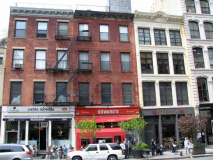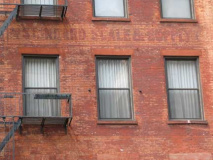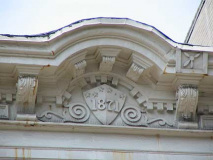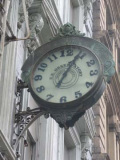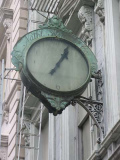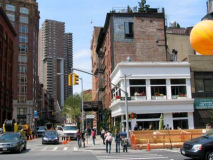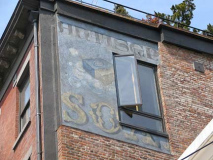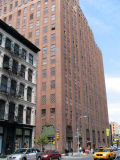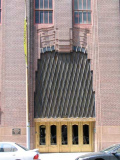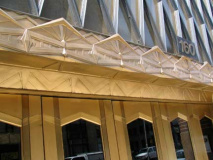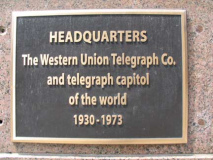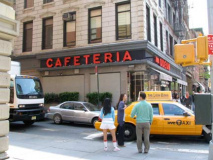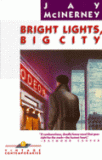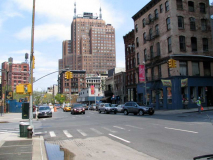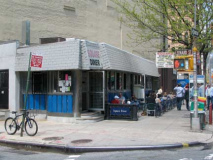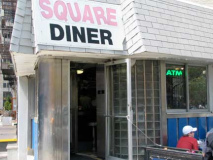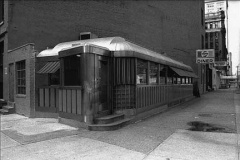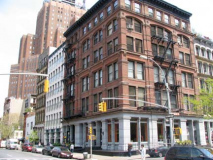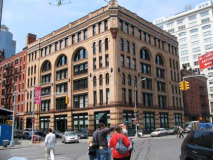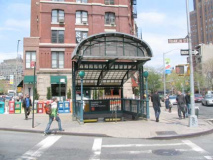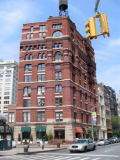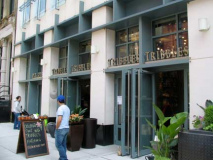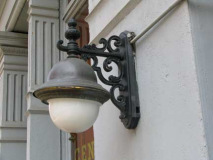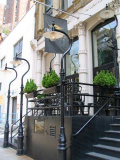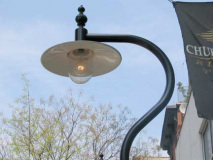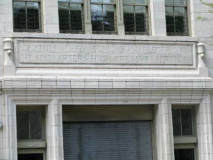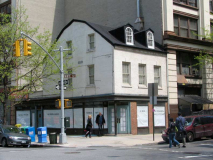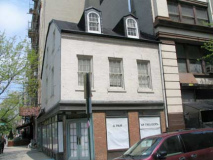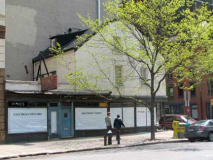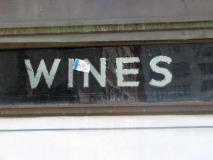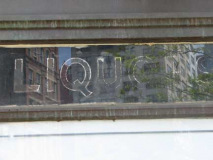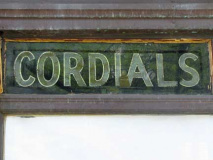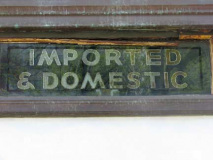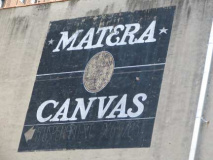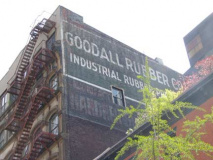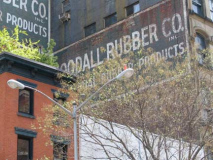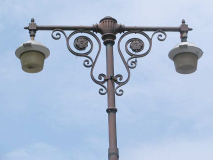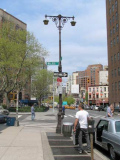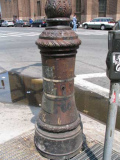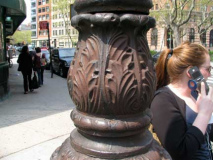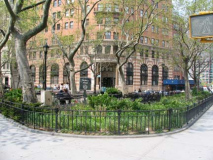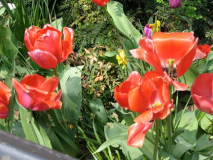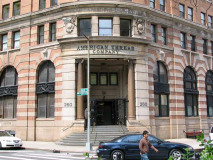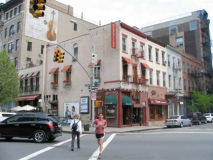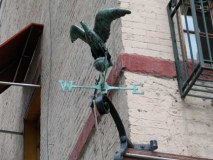Continued from West Broadway Part 1
Here’s the scene on West Broadway between Duane and Thomas Streets. All the buildings are from 1860-1875, and two have “Easter eggs” that give clues about them.
“Standard Scale & Supply Co.” former business
1871, date of construction. With a 6-star shield; one star has fallen off.
Duane Street east of West Broadway. One of the most beautiful building closks in the city; one side was redone awhile ago, while the other is the original.
I’m not sure what the “original” side says…it’s either Nath’l (Nathaniel) Fisk or Fish, and the next couple words have rusted away. In May 2008, the building was scaffolded and covered in netting, but the clock is still there; the renovators are keeping it place. I hope.
Check the painted ad on the building above the Bouley Bakery on the corner of Duane and West Broadway for “antisep… soa….” Is this an original? It looks to your webmaster’s amateurish eye to perhaps be from a movie set. In any case, I dig the liturgical-style lettering on “antiseptic”; they resemble Frederic Goudy’s 1905 Caxton Initials.
The hulking, yet delicately decorated Western Union Building occupies the whole block between West Broadway and Hudson, Thomas and Worth Streets. It was constructed in 1930 by Voorhees, Gmelin and Walker. The building employs 19 shades of brown brick. The building’s actual address is 60 Hudson Street.
“This building is the nerve center for international communications and is known as the most important carrier hotel in the world. The lifeblood of the Information Economy pulses through this building’s sturdy infrastructure, with fiber optic cable packing the risers. 60 Hudson Street is the home of at least sixty-five telecom companies.
The 943,000 square foot facility was built between 1928 and 1930 at a cost of $ 45,000,000 which equates to $ 428,000,000 in today’s market. It initially housed seventy million feet and thirty miles of conduit.” NYC Architecture
The building (2008) now houses Qwest, Broadwing,Global Crossing, General Telecom, Cablevision Lightpath, AT&T, Worldcom, TimeWarner Telecom, Gulfnet USA, Wiltel, Primus, GTE – Verizon, Viatel Global Communications, MFN, Cable & Wireless, Intermedia Corp, Teleglobe, VarTec.
Your webmaster is not the kind of guy who would be at a place like this at this time of the morning. At 11:30, after all, it’s too early for lunch. There has been a diner here at West Broadway and Thomas Street since 1938; for most of its life it was the Towers Cafeteria, and when Tribeca was mainly a manufacturing and wholesale goods center it was pretty much the only eatery in the area. It was purchased in 1980 by British restaurateur Keith McNally:
They borrowed some money, changed very little, and opened it as Odeon in 1980. The Saturday Night Live team, who had often come in to One Fifth to party after recordings (the producer, Lorne Michaels, had become a particularly close friend) transferred their loyalties, and John Belushi would walk into the Odeon kitchen and cook
his own hamburgers. Artists, gallery owners and writers who lived and worked in the area also flocked to the new brasserie, creating a sense of the place as sparkily alternative that has never quite gone away. UK Guardian
The Odeon, of course, was immortalized on the cover and in the pages of Jay McInerney’s breakthrough novel Bright Lights, Big City which became a movie starring Michael J. Fox and Keifer Sutherland long before his 24 days. I read the novel years ago and it was entertaining enough, but I was put off by its depiction of the constant
cocaine and drug use by my peers in their 20s and 30s. My vices have always been confined to unhealthy food.
Years ago a ForgottenFan and I were going back and forth about a date at the Odeon, but it never happened and thus, I’ve never actually eaten there.
West Broadway and Worth, looking north. Looming ahead is the massive AT&T Long Lines Building at 6th Avenue and Walker Street, and if you think it looks like the Western Union Building we just saw, don’t be too surprised since it was expanded from its original building in 1930-32 by McKenzie, Voorhees, and Gmelin, two of whom worked on the WU building; Ralph Walker did the interior lobby.
And, looming downtown as we look south is the new 7 World Trade Center, built by architect David Childs to replace the original 7 WTC, which collapsed from structural damage on 9/11/01 several hours after the Twin Towers fell. Your webmaster arrived at the opening ceremonies concert on May 23, 2006 a bit late to catch Lou Reed or Suzanne Vega but did catch the Brazilian Girls.
Tiny Square Diner, NW corner of West Broadway, Varick and Leonard Streets, is a little more affordable than the Odeon.
LEFT: here it is in the 70s, when it was known as the Triangle Diner (it’s opposite another of Tribeca’s triangle plots, formed by West Broadway, Varick and Franklin Streets, known, naturally, as Finn Square. Skyscraper City
The triangle was formed in 1918 when Varick Street was extended south to run into West Broadway; it had previously ended at Franklin. It was named for a popular local judge and politician, “Battery Dan” Finn, and his son, World War I hero Philip S. Finn.
Two excellent buildings on West Broadway, Franklin and Varick Streets. The building on the right, NW corner Varick and Franklin, is the original offices of the Walton Paper Co. and was designed by Albert Wagner, who also did the famed Puck Building on East Houston and Lafayette Streets.
LEFT: 1881 brick building designed by George W. Da Cunha.
The Franklin Street IRT station has its own impressive entrance kiosk.
The trouble with Tribbles. The nightspot is in a new residential building that took the place of El Teddy’s, the outlandishly decorated bar that boasted a large 5-spiked Statue of Liberty crown on its roof.
Another great lamp, West Broadway and Franklin
Churrascaria Plataforma, a Brazilian steakhouse next door at 221 Franklin, with retro-lampposts outside. The back-swept lamps are reminiscent of London’s old lightposts…none of which I can find on the nets at the moment.
The white terra-cotta sculptured building at 226 West Broadway north of Franklin was built in 1912 as the FDNY High Pressure Service Headquarters, as you can see on the facade. It later transferred to the Dept. of Water Supply, Gas ands Electricity.
In a neighborhood chock full of very, very old buildings, landmarked #2 White Street (the Gideon Tucker House), at the NE corner of west Broadway, is the most venerable. It was built in an old-fashioned style in 1808-1809; it resembles buildings from the mid-18th Century. In the 1850s, a dumbwaiter carried partiers to a dancehall in the
basement, Shadow City. The bottom floor has always sold alcoholic beverages, as a liquor store or bar…
The most recent 1st-floor tenant, the Liquor Store Bar, retained the old store signs on the painted window glass, but it lost its liquor license, along with other nearby taverns, because of the presence of a mosque in the area.
Some good ads…Matera Canvas, 5 Lispenard Street two blocks away, and a twofer from Goodall Rubber, at West Broadway and White. The only person to turn to in this case is Walter Grutchfield:
The Goodall Rubber Co., established in Philadelpha in 1906, opened its New York City office in 1911 at 12 Gold St. The New York branch was a sales and warehouse operation. Manufacturing took place in Philadelphia and later in Trenton. Goodall had several locations in lower Manhattan before moving to this building at 5 White St. in the late 1930’s. Probably the signs were painted at that time. Goodall remained in this building until the 1970’s when they left the city and relocated the office to Rutherford, New Jersey.
The Walker Twin
Arriving at Walker Street, I couldn’t resist a jog east to 6th Avenue, where a Type 24M Twin is still holding forth…with its center finial gone, and long disgraced by out-of-context sodium “bucket” lights…
Relatively speaking the Walker twin at 6th and Walker is relatively new. This section of 6th Avenue was opened in 1928, when the IND 6th Avenue line was under construction. I’m not aware of any other Twins ever on 6th, but the avenue got modern “octa-poles” as early as the 1950s.
West Broadway comes to a temporarily screeching halt at Beach Street and Tribeca Park. In 1809 the Common Council agreed that the intersection of Beach, Walker, and Chapel (now West Broadway) should be “converted to a Park.” The following year the City of New York purchased the land from William I. and Elizabeth Waldon for a sum of $3950.
For over a century the park was known as Beach Street Park. Although the original design is not known, the Department of Parks Annual Report from 1871 details the expansion and reconstruction of the park at that time. The site was excavated, and a new stone foundation was laid down. The interior plot was planted and surrounded by an iron railing and a twelve-foot-wide sidewalk. By 1936 Beach Street Park featured six trees and six benches inside the iron railing, and ten trees and a water trough on the perimeter. Of note, the granite pavers on the site were laid in earth, and the joints were seeded with grass.
Since 1985 the site has been known as TriBeCa Park in tribute to the surrounding neighborhood, which in turn takes its name from its geographical location. NYC Parks
With a name like that, he’s got to be good. The imposing American Thread Company building at the NW corner of Beach Street and West Broadway was built as the Wool Exchange Building in 1896 by William Bunker Tubby, who also designed the Pratt Institute Library in Brooklyn.
I was attracted to Pepolino, a Tuscan-themed ristorante at the NE corner of West Broadway and Lispenard
Street…for its verdigris’ed weathervane.
Continue to West Broadway Part 3!


